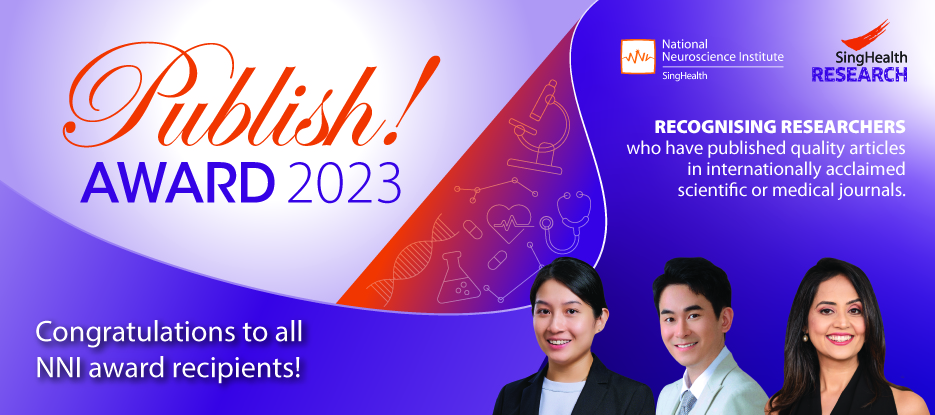Dr Jasmine Koh Shimin, Dr Jack Lo Yu Tung and Dr Sumeet Kumar have been awarded the SingHealth Publish! Award 2023, which recognises researchers with quality published articles.

NNI recipients of SingHealth Publish! Award 2023, (left to right) Dr Jasmine Koh Shimin, Dr Jack Lo Yu Tung and Dr Sumeet Kumar.
Three NNI clinicians have been recognised for their quality research articles which were published in internationally acclaimed scientific or medical journals. Dr Jasmine Koh Shimin, Consultant, Neurology, Dr Jack Lo Yu Tung, Senior Resident, Neurosurgery, and Dr Sumeet Kumar, Senior Consultant, Neuroradiology, received their awards at the SingHealth Publish! Award ceremony on 30 August 2023.
Read on to find out more about the clinical problems their research is tackling and how the findings will help advance care.
Low Incidence of Neurological Recurrent Side-effects Following COVID-19 Reimmunization
First author: Dr Jasmine Koh Shimin
What problem was your research trying to solve? Individuals who suffered a neurological event after taking the first dose of COVID-19 vaccine may hesitate and defer taking the second dose. The safety of reimmunization among this group of individuals has not been systematically examined.
How is your research taking the knowledge forward? We observed that only 2% of individuals who suffered a neurological event after the first dose of COVID-19 vaccine suffered a recurrence within 6 weeks of the second vaccine dose, suggesting that individuals should not delay immunization due to a prior neurological event. Further studies would need to be done to confirm the attribution of these neurological events to vaccination.
Read the full research paper here.
A Prognostic Model Using Post-Steroid Neutrophil-Lymphocyte Ratio Predicts Overall Survival in Primary Central Nervous System Lymphoma
First author: Dr Jack Lo Yu Tung
What problem was your research trying to solve? Primary central nervous system lymphoma (PCNSL) is a type of brain tumour that responds relatively well to chemoradiotherapy (unlike most other brain tumours). However, accurately predicting survival outcomes remains challenging.
How is your research taking the knowledge forward? There has been increasing evidence that the ratio of different types of white blood cells, specifically the neutrophil-lymphocyte ratio (NLR), correlates with survival in many types of cancer. In PCNSL and other cancers, a higher NLR at baseline usually indicates a worse prognosis. However, when individuals with PCNSL are treated with corticosteroids to reduce brain swelling, it decreases the number of lymphocytes and increases the number of neutrophils, thus changing their balance in the blood. Interestingly, a higher NLR after receiving corticosteroids was actually linked to better survival. Based on this finding, we developed a new prognostic score that assesses the likelihood of survival using a combination of age, NLR before corticosteroid treatment, and NLR after corticosteroid treatment.
Read the full research paper here.
Topology of Diffusion Changes in Corpus Callosum in Alzheimer's disease: An Exploratory Case-Control Study
First author: Dr Sumeet Kumar
What problem was your research trying to solve? We studied the white matter changes in the patients with Alzheimer's disease (AD) using MRI brain. Classically, AD is described as a disease involving the grey matter of the brain. However, recently, more attention is being paid to the abnormalities in the white matter of the brain in AD patients. We wanted to examine and understand the pathological changes occurring in the white matter using this non-invasive MRI technique with advanced pulse sequences. We selected to study the changes in the thick bundle of white matter fibres connecting the two cerebral hemispheres – the corpus callosum, in patients with AD and compare them to healthy subjects. The MR technique used was based on analysing the direction of diffusion of water molecules in the white matter- pulse sequences such as Diffusion Tensor Imaging (DTI) and Diffusion Kurtosis Imaging (DKI). We applied white matter tract integrity model to the data and generated several metrics to infer the biophysical changes happening in the white matter of AD patients.
How is your research taking the knowledge forward? We found that the white matter tracts in the corpus callosum of AD patients were abnormal and showed changes due to degeneration and demyelination of the white matter. The mid-anterior and mid-posterior segments of the corpus callosum showed the most prominent abnormalities. Of all the metrics examined, we were able to identify one metric that was most significantly altered – the Axonal Kurtosis (AK). This metric, AK, also correlated with impairment in many cognitive domains in AD patients. This metric may be an important non-invasive MR imaging biomarker for AD and needs to confirmed by larger studies.
Read the full research paper here.
